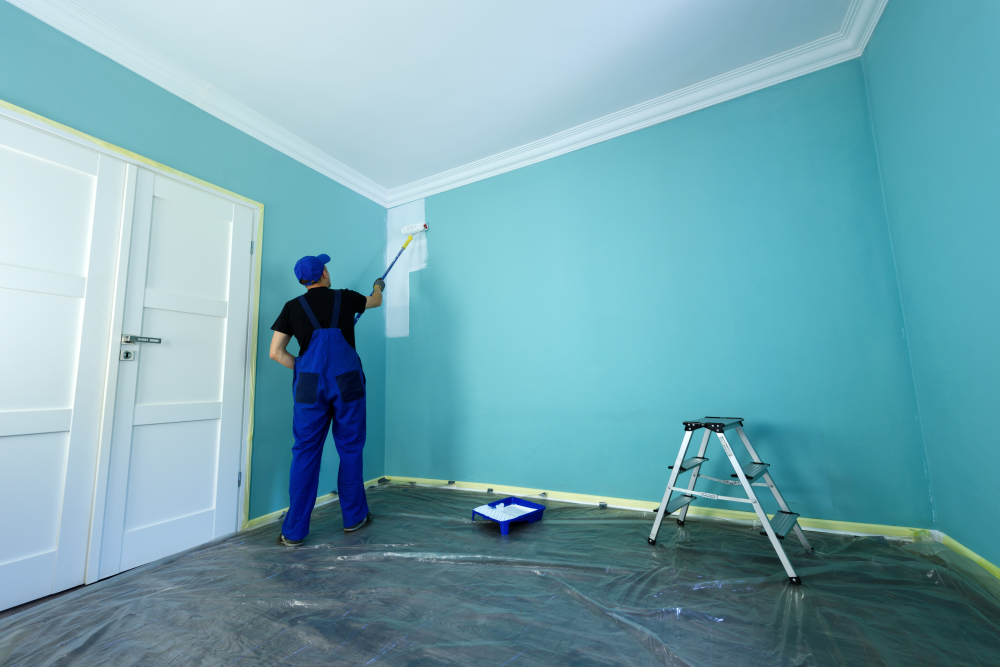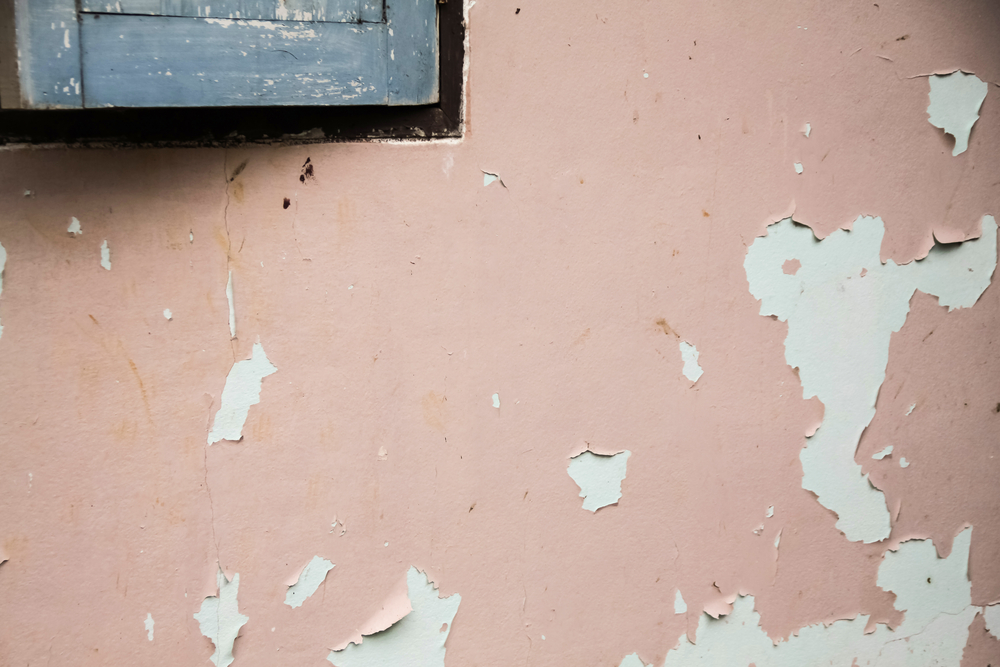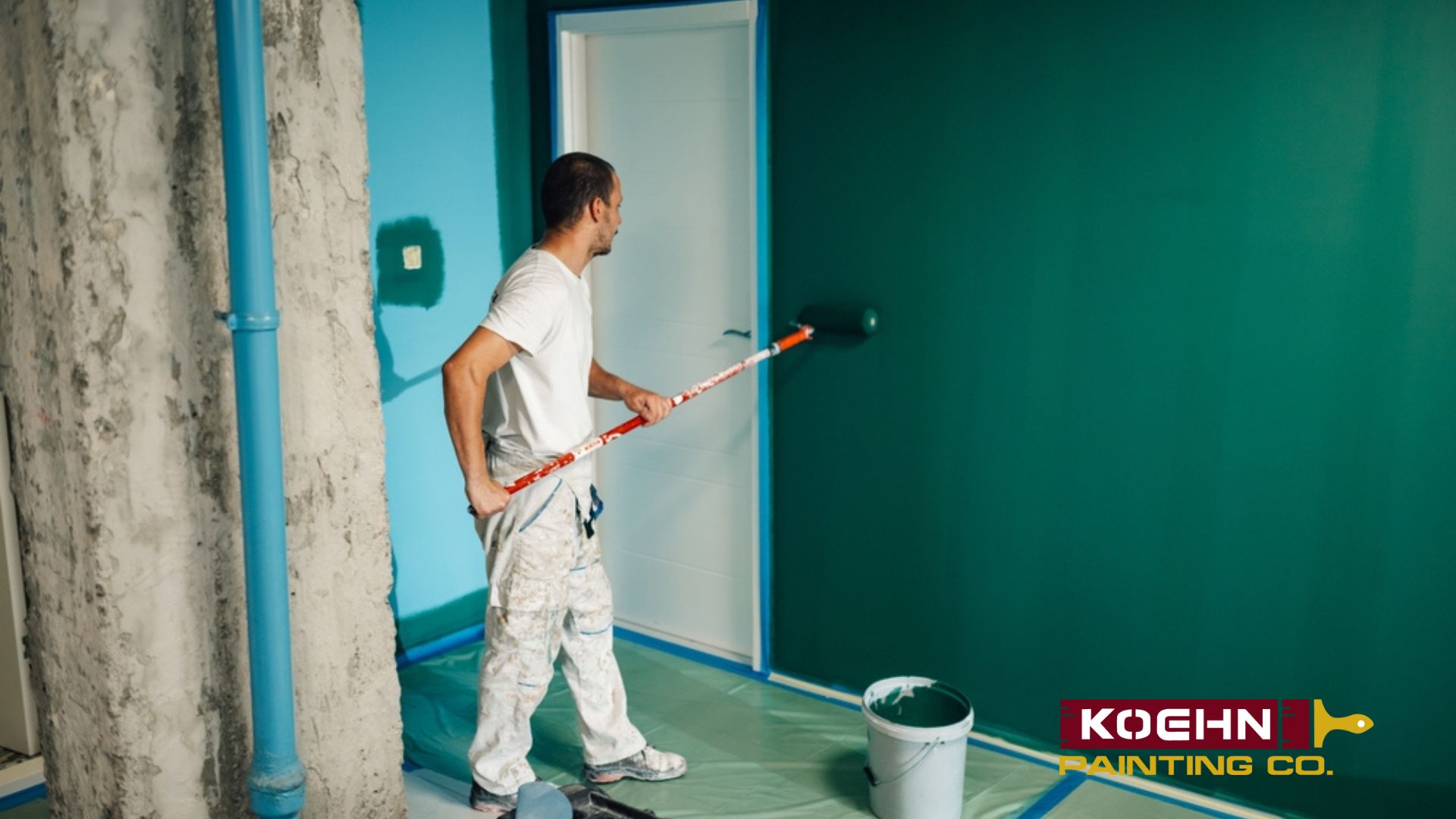Table of Contents
ToggleHiring a professional painting contractor goes much further than convenience; it’s about ensuring quality, safety, and lasting results. While DIY painting might seem like a way to save money, it often results in uneven finishes, wasted materials, and safety hazards. If you’re wondering how to hire a painting contractor, start by understanding what makes professionals different.
They use specialized equipment like industrial sprayers, scaffolding, and precision brushes to guarantee smooth coverage and sharp lines.
Moreover, their insurance coverage and adherence to safety standards protect homeowners from potential accidents or property damage. With expert knowledge of materials, weather conditions, and surface types, they deliver durable finishes that maintain your home’s beauty and structural integrity for years to come.
When learning how to hire a painting contractor, the process begins with verifying credentials and reputation. Always confirm that the painter is licensed and insured, and review references or Better Business Bureau (BBB) ratings to gauge reliability.
Detailed written estimates are crucial—they should outline prep work, paint brands, coat numbers, cleanup details, and payment terms. Preparation often determines longevity, so choose contractors who emphasize repairs, priming, and protective measures for furniture and flooring. Keep these key steps in mind:
- Verify credentials: Check licenses, insurance, and reviews for reliability.
- Request written estimates: Make sure they include prep, materials, timeline, and payment schedule.
- Ask the right questions: Who will perform the work? What warranty is offered? How do they handle lead paint?
The right contractor will answer confidently and transparently, ensuring you understand every part of the process before work begins.
Common mistakes can quickly derail an otherwise smooth painting experience. Homeowners often misjudge timing, choose painters solely based on price, or skip contract details altogether. Other pitfalls include overlooking paint quality, misunderstanding warranties, and neglecting to ask for maintenance instructions.
To avoid these issues, request at least three comparable estimates, make sure the scope and materials are clearly outlined, and verify warranty coverage for both labor and materials. A few points to remember:
- Avoid choosing based only on price: Cheap bids often sacrifice prep and product quality.
- Clarify warranty details: Ensure both materials and workmanship are covered.
- Request a maintenance guide: Learn how to care for your paint job after it’s finished.
- Compare estimates line by line: Ensure each contractor includes the same scope before judging costs.
Remember, the lowest quote is often the most expensive mistake in disguise.
Ultimately, hiring a local painter offers unmatched value—combining community accountability with regional expertise. Local contractors understand how climate affects paint performance and are easier to reach for follow-ups or touch-ups.
Let’s explore all of this in more detail in the upcoming sections.
Why Hiring a Pro Painter Pays Off More Than You Think
Most homeowners start a paint project thinking, “How hard can it be?”—until they’re two ladders deep, juggling paint cans, and realizing that the pros make it look easy because they’ve mastered every detail of the process. Hiring a professional painting contractor saves time, yes, but it’s also about getting results that actually last.
Professional painters bring efficiency, safety, and craftsmanship that DIY projects rarely achieve, especially for large homes, complex details, or multi-story exteriors. Here’s why choosing a contractor pays off in the long run:
- Professional tools and equipment
Contractors invest in top-grade tools like:
- Airless sprayers and industrial rollers for smooth, even coverage.
- Scaffolding and extension ladders that improve safety in high or difficult-to-access areas.
- Specialized brushes and caulking systems that ensure crisp lines and sealed joints.
These tools help minimize overspray, conserve paint, and achieve a professional finish most homeowners can’t replicate.
- Safety and insurance
DIY painting often means balancing on ladders and working around electrical fixtures, a serious safety risk.
- Licensed painting contractors carry liability insurance that protects both the worker and your property.
- They also use safety harnesses, helmets, and stabilizers that meet industry standards.
- If an accident or damage occurs, you’re not the one footing the bill.
- Expertise and efficiency
Professionals know how to:
- Evaluate various materials (wood, stucco, metal, brick) and select the appropriate primers and finishes.
- Plan projects around weather and humidity for optimal curing.
- Work in teams to cover large areas quickly and consistently.
Their experience cuts down on wasted time and costly errors. What might take you two weekends, a pro team finishes in two or three days.
- Quality paints and materials
The quality of paint and prep materials makes or breaks a job. Professional painters use:
- Premium exterior acrylics and sealants that resist cracking, peeling, and fading.
- Primers matched to surface type and climate, ensuring strong adhesion.
- Weather-tested finishes that extend the paint’s lifespan, saving you from repainting every few years.
- Guaranteed results
Unlike DIY work, professional painters back their craftsmanship.
- Many offer written warranties covering premature peeling, blistering, or fading.
- Some, like Dyson Painters, guarantee satisfaction or free touch-ups if issues arise.
- You also get clear timelines and contracts, meaning no guesswork about what’s included.
- Long-term value
A professional paint job not only looks better, but also protects your home’s structure from moisture and UV damage. That durability translates into:
- Fewer repaint cycles.
- Lower long-term maintenance costs.
- Higher resale value when it’s time to move.
Hiring a contractor means investing in safety, longevity, and peace of mind. You’re paying for knowledge, accountability, and results that truly last.
How to Choose the Right Interior Painting Services for Your Home

Choosing the right interior painting services involves more than just browsing online reviews or selecting the lowest price. The best results come from painters who combine skill, transparency, professionalism, and helpful tips, treating your home as carefully as they would their own.
The difference between a great contractor and a regrettable one often comes down to how well you vet them before work begins. If you’ve ever wondered how to hire a painting contractor who’s actually worth the investment, here’s exactly what to look for.
I. Start with credentials and reputation
Before anything else, verify the painter’s license and insurance.
- Request proof of liability and workers’ compensation insurance—this safeguards you if accidents occur on-site.
- Check BBB ratings, reviews, and complaint history. A clean record shows reliability and accountability.
- Browse local references or neighborhood groups for verified experiences. Contractors who value reputation rarely cut corners.
II. Get detailed estimates
Then, detailed written estimates are important. These should include:
- Surface prep steps (washing, sanding, caulking, priming).
- Exact products and brands of paint being used.
- Number of coats, project timeline, and cleanup plan.
- Payment terms, including deposit requirements and milestone billing.
A vague or verbal quote is a red flag. Clear documentation ensures both sides know what to expect, keeping misunderstandings off the table.
III. Evaluate their prep standards
Great painters know the secret to a long-lasting finish is preparation, not the final coat. Ask how they handle:
- Repairs for cracks, nail holes, or damaged drywall.
- Primer selection for specific surfaces.
- Masking and covering furniture, flooring, and fixtures.
Professionals who skip these steps may deliver fast results, but not durable ones. Professionals note that most paint failures start beneath the surface, from poor prep, not bad paint.
IV. Ask the right questions before hiring
It’s highly recommended to interview at least three contractors before making a decision. Here are smart questions to guide that conversation:
- How many years have you been in business? Experience often translates to consistency and reliability.
- Who will actually do the work — your team or subcontractors? Knowing who’s on-site helps set accountability.
- What brand and grade of paint will you use? Pros should be able to justify their product choice.
- How do you protect my home during painting? Look for clear systems around masking, ventilation, and cleanup.
- Do you offer a warranty or touch-up policy? Trustworthy contractors stand behind their work.
- Can I see recent projects or reviews from similar jobs? A reputable pro will gladly share their portfolio or references.
How a contractor responds to these questions reveals a lot about how they’ll communicate once the job begins.
V. Prioritize communication and contracts
Once you’ve chosen your painter, insist on a written agreement before work begins. It should clearly state:
- The full scope of work.
- Materials and paint specifications.
- Timeline and payment schedule.
- Warranty and cleanup terms.
Transparency fosters trust. Reputable companies use contracts not only to protect themselves but also to make sure clients understand exactly what they’re paying for. No hidden add-ons, and definitely no vague promises.
VI. Understanding each house’s particularities
If your home was built before 1978, there’s a good chance old paint layers contain lead, which can pose serious health risks when sanded or stripped.
- Contractors must take lead-safe precautions, following EPA standards for containment and cleanup.
- Always ask: “Have you worked on lead-paint homes before?” and “What safety steps do you take to protect the space?”
- Do not hire anyone who dismisses the issue or says they’ll “just paint over it”—shortcuts here can be dangerous and illegal.
Ultimately, you should seek a partner beyond just a painter. The top interior painting services do more than just paint walls; they guide you through the process with transparency, communication, and care. If you want to know how to hire a painting contractor who provides consistent results, find one who values trust as much as skill.
They’ll show up prepared, keep your home protected, and leave behind something that lasts, a clean, polished finish that elevates every room.
Contact us here if you would like to find the best painting contractor for your residential or commercial painting needs.
8 Common Mistakes (and One Extra One) You’ll Want to Avoid When Hiring Painters

Even with good intentions, many homeowners stumble into the same mistakes when hiring painters. We’re talking about choosing based only on price, skipping contracts, or trusting someone without verifying references. These mistakes can quickly turn a simple refresh into a costly redo.
To help you avoid frustration, we’ve pulled some key insights to break down the most common mistakes people make when deciding how to hire a painting contractor, and what to do instead.
Mistake #1: Misjudging project timing
Painting is more than color; it’s about conditions. Many homeowners rush into scheduling interior or exterior projects during humid, hot, or freezing months, only to find their paint peeling or bubbling within weeks.
What you can do instead is ask your contractor when your home type and paint system perform best.
- Exterior: Aim for dry, mild weather—roughly 50–70°F (10–21°C).
- Interior: Avoid heavy humidity or new construction dust.
A good contractor will delay a job rather than compromise adhesion or curing. If your painter doesn’t mention weather or climate timing, they’re not planning long-term.
Mistake #2: Assuming all “interior painting services” are the same
Not every painter handles every surface well. Hiring someone who mainly does exteriors for your indoor renovation (or vice versa) can cause inconsistent finishes, poor ventilation control, or mismatched paint chemistry.
What to do instead:
- Ask what portion of their business comes from interior painting services specifically.
- Verify that they use low-VOC or odor-free products designed for enclosed spaces.
- Request sample finishes — pros should demonstrate how they handle corners, trims, and ceilings differently.
Top-tier painters tailor materials and methods to room type (bathrooms, kitchens, bedrooms) — it’s not one-size-fits-all.
Mistake #3: Overlooking color and finish consultation
Homeowners often choose colors directly from swatches or online images, only to regret how they appear under actual lighting. Omitting expert advice can lead to hues that clash with furniture or finishes that scratch easily in busy areas.
But there’s a solution: many teams offer a color consultant or digital preview before painting. Ask your painter to test small patches in different lighting. They can advise whether satin, eggshell, or semi-gloss will last better for your room type.
This not only prevents visual mistakes but also saves money on redoing entire sections later.
Mistake #4: Not understanding how painters charge
One of the most confusing aspects of hiring painters is pricing. Homeowners often ask, “What is the normal hourly rate for a painter?” but miss the bigger question: what’s actually included in that rate?
Pros build quotes around scope and surfaces: room size and wall height, paint type, prep/repairs, ceilings, and any special features. For example, in Wichita:
- Bedrooms often run $300–$750
- Larger living rooms $900–$2,000
- Whole-home interiors typically cost $3,000–$7,000 for about 1,000 sq ft or $4,500–$10,500 for roughly 1,500 sq ft, not including add-ons like heavy repairs or accent walls.
Materials matter as well: latex paints usually cost $15–$50 per gallon, oil-based paints range from $20–$60 per gallon, and ceilings are priced differently because they’re more difficult to paint; expect to pay $150–$350 per ceiling or $1–$2.50 per square foot.
Those ranges swing with surface condition (patching, skim, primer), texture, and color choices (deep hues often need more coats)
Before you sign, make the estimate crystal clear, in writing. Ask:
- What’s included? Exact rooms, ceilings, closets, trim, doors, accent walls.
- Prep and repairs: Who is responsible for patching, sanding, priming, and what standards are used?
- Materials: Brand/line of paint, finish, number of coats, and estimated gallons.
- Complexities: Tall walls, heavy texture, cabinet/trim enameling, popcorn removal, specialty ceilings.
- Logistics & cleanup: Furniture moving, masking, daily site protection, disposal plan.
- Schedule & payments: Start/finish dates, milestones, deposit, and warranty/touch-up terms.
Want to keep costs in check? Get multiple bids, insist on a detailed contract, do simple prep yourself (moving furniture, basic wall cleaning), recoat on time to reduce heavy prep later, and pick colors that cover efficiently.
DIY can save on tiny projects (supplies often $100–$200 for a room; $200–$600 for a ceiling), but ceilings and complex prep quickly erase those savings—another reason to compare like-for-like scopes, not just the bottom line.
Mistake #5: Misinterpreting warranties and guarantees
A “warranty” sounds appealing until you realize it only covers paint, not labor. That means if your walls peel in six months, you might still have to pay for the repair.
What you want to do is:
- Clarify if the warranty includes both materials and workmanship.
- Ask: “Who covers touch-ups or peeling within the first two years?”
- Get it in writing. Consumer Reports warns that paint warranties don’t include the most expensive part — reapplication labor.
Reliable contractors provide written guarantees for both materials and labor to ensure added confidence.
Mistake #6: Letting painters choose materials without input
Yes, we understand you’re not a painter. However, homeowners often let painters “handle the paint order,” blindly trusting them and probably assuming all brands are the same. Some lower bids hide cheap paint choices that fade, chalk, or peel early.
Specify your preferred brand and quality level in the quote. Reputable painters will gladly use premium-grade acrylics or enamels that last longer and resist scuffs.
Bargain paints often require double coats and frequent touch-ups, costing more in the long run.
Mistake #7: Forgetting to ask about post-project maintenance
Even the best paint job needs care. Homeowners rarely ask how to maintain it, leading to premature fading or accidental damage during cleaning.
Before final payment, ask for a maintenance guide or recommendations:
- When can you safely wash walls?
- What cleaners are safe for your chosen paint type?
- When to recoat high-touch areas (like baseboards or kitchen walls)?
Top companies provide aftercare advice to extend your paint’s lifespan, an underrated sign of professionalism.
Mistake #8: Failing to evaluate estimates strategically
The most effective way to evaluate painting bids isn’t based on price. It’s on clarity and completeness.
Here’s what to look for:
1. Compare at least three written estimates.
- Each should break down own labor, materials, prep, and cleanup.
- Avoid contractors who offer verbal quotes or “ballpark” numbers.
2. Understand scope differences.
If one painter includes sanding and priming but another doesn’t, that’s not a fair price comparison. Always ensure all painters bid on the same scope.
3. Ask for the paint specs in writing.
That means brand, finish, and number of coats. Low-end paints fade faster and require earlier repainting.
4. Watch for red flags.
🚩 Unusually low estimates (they’ll cut corners).
🚩 Full payment before work begins.
🚩 No itemized list or vague “miscellaneous charges.”
5. Verify the timeline.
A realistic project schedule signals professionalism, not “we’ll fit you in somewhere next month.”
When in doubt, ask your contractor to explain each line. A professional won’t hesitate; they’ll appreciate that you’re detail-oriented.
Not a mistake, but you’ll like it
This last one is not particularly a mistake, but it’s an essential answer to the question, “Is it cheaper to hire a painter or do it yourself?”
The quick answer: usually not. While DIY painting appears to save money initially, the reality often shows otherwise. Supplies, scaffolding, cleanup, and time quickly add up, and if mistakes happen, fixing them doubles your costs.
Professional painters buy paint at trade discounts, complete projects in days instead of weeks, and ensure consistent results backed by warranties. So while hiring may cost more upfront, it often saves money in the long run, especially for complex interiors, ceilings, or textured surfaces.
Think of it this way: if your time is valuable, hiring painters is an investment in both quality and peace of mind.
Hire a Local Painter Instead
If you’re torn between a big-name franchise and a neighborhood professional, here’s a tip: hire a local painter instead. Local contractors know your climate, the regional building materials, and which paints actually hold up through your city’s heat, humidity, or cold. They’re easier to reach for follow-ups, more responsive to scheduling, and often more invested in their reputation within the community.
Choosing local also means your money stays within the community, supporting small businesses while offering faster, more personalized service. When learning how to hire a painting contractor, prioritizing a local expert is one of the smartest moves you can make for reliability and accountability.
Learning how to hire a painting contractor isn’t just about finding someone who can hold a brush; it’s about finding a partner who respects your home, communicates clearly, and delivers durable, lasting results.
Skip these common mistakes, ask better questions, and compare estimates wisely. When you do, you’ll find that hiring painters who value honesty and craftsmanship pays for itself, in quality, peace of mind, and a finish that actually lasts.
Conclusion: How to Hire a Painting Contractor the Smart Way

Hiring a painter isn’t just about color—it’s about trust, craftsmanship, and long-term value. Knowing how to hire a painting contractor means looking beyond price tags and focusing on experience, transparency, and protection for your home. A professional contractor brings more than tools: they bring knowledge of materials, surface prep, climate conditions, and safety that ensures your paint job lasts for years.
For interiors or exteriors, remember: clear contracts, written estimates, and honest communication distinguish great pros from costly mistakes. Local interior painting services often provide the added benefits of quicker responses, personalized service, and familiarity with your region’s weather and building styles.
So before picking up a brush—or hiring the first name you find online—take the time to vet credentials, compare bids, and ask the right questions. Investing in a qualified painter now protects your biggest investment later.
Discover the Koehn Painting difference – contact us today for a free estimate and step into a vibrant, freshly painted home!




